Lunch
The Meals Series
as part of the Rowman & Littlefield Studies in Food and Gastronomy
General Editor: Ken Albala, Professor of History, University of the Pacific (kalbala@pacific.edu)
Rowman & Littlefield Executive Editor: Suzanne Staszak-Silva (sstaszak-silva @rowman.com)
The Meals series examines our daily mealsbreakfast, lunch, dinner, teaas well as special meals such as the picnic and barbeque, both as historical construct and global phenomena. We take these meals for granted, but the series volumes provide surprising information that will change the way you think about eating. A single meal in each volume is anatomized, its social and cultural meaning brought into sharp focus, and the customs and manners of various peoples are explained in context. Each volume also looks closely at the foods we commonly include and why.
Breakfast: A History , by Heather Arndt Anderson (2013)
The Picnic: A History , by Walter Levy (2013)
Lunch: A History , by Megan Elias (2014)
Lunch
A History
Megan Elias
Rowman & Littlefield
Lanham Boulder New York Toronto Plymouth, UK
Published by Rowman & Littlefield
4501 Forbes Boulevard, Suite 200, Lanham, Maryland 20706
www.rowman.com
10 Thornbury Road, Plymouth PL6 7PP, United Kingdom
Copyright 2014 by Rowman & Littlefield
All rights reserved . No part of this book may be reproduced in any form or by any electronic or mechanical means, including information storage and retrieval systems, without written permission from the publisher, except by a reviewer who may quote passages in a review.
British Library Cataloguing in Publication Information Available
Library of Congress Cataloging-in-Publication Data
Elias, Megan J.
Lunch : a history / Megan Elias.
pages cm. (The meals series) (Rowman & Littlefield studies in food and gastronomy)
Includes bibliographical references and index.
ISBN 978-1-4422-2746-0 (cloth : alk. paper) ISBN 978-1-4422-2747-7 (electronic) 1. LuncheonsHistory. 2. Food habitsHistory. I. Title.
GT2960.E45 2014
394.1'209dc23
2013037133
 The paper used in this publication meets the minimum requirements of American National Standard for Information SciencesPermanence of Paper for Printed Library Materials, ANSI/NISO Z39.48-1992.
The paper used in this publication meets the minimum requirements of American National Standard for Information SciencesPermanence of Paper for Printed Library Materials, ANSI/NISO Z39.48-1992.
Printed in the United States of America
Series Foreword
C ustom becomes second nature, and this especially true of meals. We expect to eat them at a certain time and place, and we have a set of scripted foods considered appropriate for each. Bacon, eggs, and toast are breakfast; sandwiches are lunch; meat, potatoes, and vegetables are dinner, followed by dessert. Breakfast for dinner is so much fun precisely because it is out of the ordinary and transgressive. But meal patterns were not always this way. In the Middle Ages people ate two meals, the larger in the morning. Today the idea of a heavy meal with meat and wine at 11:00 a.m. strikes us as strange and decidedly unpleasant. Likewise when abroad, the food that people eat, at what seems to us the wrong time of day, can be shocking. Again, our customs have become so ingrained that we assume they are natural, correct, and biologically sound.
The Meals series will demonstrate exactly the opposite. Not only have meal times changed but the menu as well, both through history and around the globe. Only a simple bowl of soup with a crust of bread for supper? Thats where the name comes from. Our dinner, coming from disner in Old French, disjejeunare in Latin, actually means to break fast and was eaten in the morning. Each meal also has its own unique characteristics that evolve over time. We will see the invention of the picnic and barbecue, the gradual adoption of lunch as a new midday meal, and even certain meals practiced as hallowed institutions in some places but scarcely at all elsewhere, such as teathe meal, not the drink. Often food items suddenly appear in a meal as quintessential, such as cold breakfast cereal, the invention of men like Kellogg and Post. Or they disappear, like oysters for breakfast. Sometimes an entire meal springs from nowhere under unique social conditions, like brunch.
Of course, the decay of the family meal is a topic that deeply concerns us, as people catch a quick bite at their desk or on the go, or eat with their eyes glued to the television set. If eating is one of the greatest pleasures in life, one has to wonder what it says about us when we wolf down a meal in a few minutes flat or when no one talks at the dinner table. Still, meal time traditions persist for special occasions. They are the time we remind ourselves of who we are and where we come from, when grandmas special lasagna comes to the table for a Sunday dinner, or a Passover Seder is set exactly the same way it has been for thousands of years. We treasure these food rituals precisely because they keep us rooted in a rapidly changing world.
The Meals series examines the meal as both a historical construct and a global phenomenon. Each volume anatomizes a single meal, bringing its social and cultural meaning into sharp focus and explaining the customs and manners of various people in context. Each volume also looks closely at the foods we commonly include and why. In the end I hope you will never take your meal time customs for granted again.
Ken Albala
University of the Pacific
Acknowledgments
I have wanted to write this book for several years, so thanks are first due to Ken Albala for creating the Meals series at Rowman & Littlefield and allowing me to take lunch. Ken is an ideal editor, both supportive and informative. I also thank Suzanne Staszak-Silva and Kathryn Knigge for shepherding the book through production. Farha Ternikar (Brunch) and Heather Arndt Anderson (Breakfast) deserve recognition for sharing ideas with me along the way. The Wertheim Study, at the New York Public Library, brilliantly curated by Jay Barksdale, gave me a beautiful and quiet place to work on this book and I will always be grateful. Warmest thanks are due to my family, Preston Johnson and Petra Diana Johnson, who gave me time to write and shared many meals, midday and otherwise with me.
Introduction
A traditional Mongolian proverb advises: Keep breakfast for yourself, share lunch with your friend and give dinner to your enemy. The meal most often eaten in public, lunch has a long history of establishing social status and cementing alliances. From the Ploughmans Lunch in the field to the Power Lunch at the Four Seasons, where, with whom, and upon what we lunch marks our place in the world.
Lunch has never been just a meal. The American School Lunch Act of 1946, inspired by the malnutrition discovered by wartime recruiters, demonstrated that lunch could represent the very health of the nation. In the 1960s, the right to eat at one of Americas ubiquitous lunch counters came to represent Americas moral health. Issues of who cooks lunch, and who eats what and how and even when (before exercise or after?) in public institutions continues to galvanize activists. Extremes of approach range from prepackaged lunchables to Alice Waterss edible schoolyards, agriculture and lunchroom linked ideologically as well as materially.
In 1987, the death knell seemed to sound for lunch when Wall Stree t s Gordon Gekko proclaimed that Lunch is for wimps and millions of office workers began to eat over their keyboards. But lunch persists and has even inspired a revivalist movement in Take Back Your Lunch, a nationwide encouragement to take the time allotted and actually leave our desks.
Lunch emerged first as a necessary pause in the hard labor of agricultural peasants and then as a facet of a new middle-class culture in Europe at the end of the eighteenth century. The word itself derived in the modern era from an old term for a slice of something, which makes the contemporary American expression lets go for a slice, meaning pizza, a historically accurate invitation to lunch.
Next page
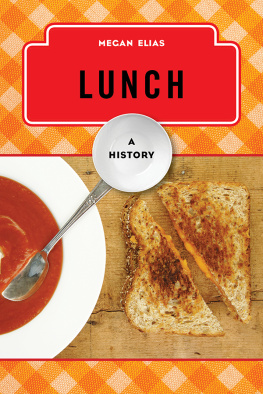
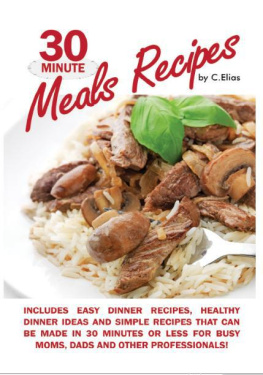


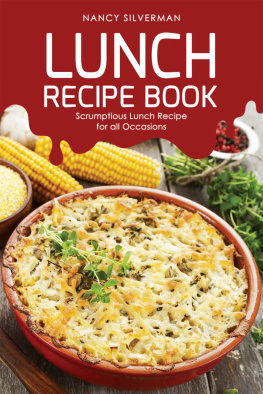
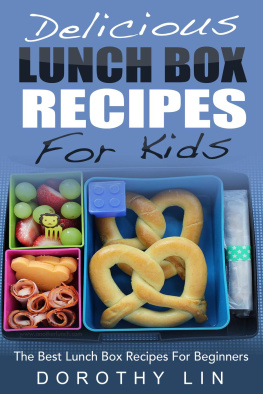


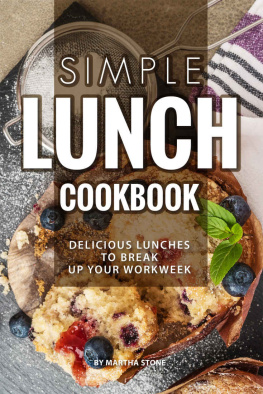
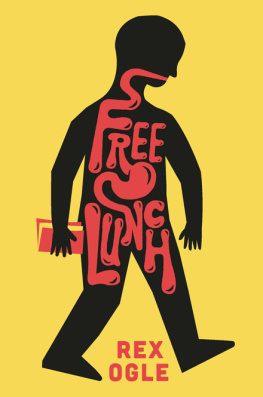

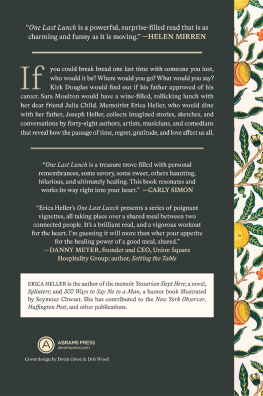
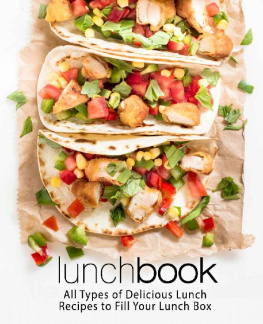
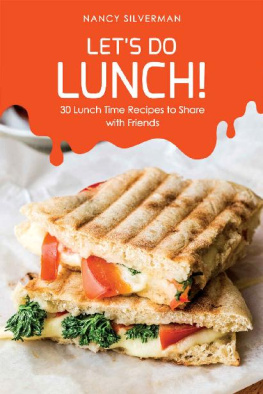
 The paper used in this publication meets the minimum requirements of American National Standard for Information SciencesPermanence of Paper for Printed Library Materials, ANSI/NISO Z39.48-1992.
The paper used in this publication meets the minimum requirements of American National Standard for Information SciencesPermanence of Paper for Printed Library Materials, ANSI/NISO Z39.48-1992.